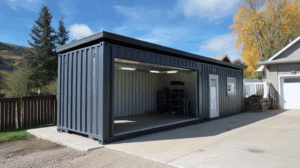Shipping Container Garage: The Modern Solution for Extra Storage and Workspace
In today’s fast-paced world, where space is at a premium, finding innovative solutions for extra storage and workspace is a top priority for many homeowners and businesses. One such solution that has gained significant popularity in recent years is the shipping container garage.
Shipping containers, originally designed for the transportation of goods across long distances, have now found a new purpose as versatile and cost-effective storage and workspace solutions. With their robust construction, weatherproof design, and modular nature, they have quickly become the go-to option for those seeking a modern and customizable solution.
Durability and Security
One of the main advantages of using a shipping container garage is its unparalleled durability. Made from high-quality steel, these containers are built to withstand the harshest of weather conditions and provide a secure storage space for your valuable belongings. Whether you need a garage for your vehicles, tools, or equipment, a shipping container is designed to keep them safe and protected.
Versatility and Customizability
Shipping container garages offer a remarkable level of versatility and customizability. With their modular design, these containers can be easily stacked or arranged side by side to create a spacious garage that meets your specific needs. Additionally, they can be modified to include windows, doors, skylights, insulation, and electrical installations, providing a comfortable and functional workspace.
Cost-Effective Solution
Compared to traditional garage construction, opting for a shipping container garage can save you a significant amount of money. The cost of purchasing and modifying a shipping container is considerably lower than constructing a traditional brick-and-mortar garage. Moreover, the construction process is much quicker, allowing you to enjoy your new storage or workspace in a fraction of the time.
Sustainable and Eco-Friendly
In an era where sustainability is a growing concern, shipping container garages provide an eco-friendly solution. By repurposing used shipping containers, you are reducing the demand for new construction materials and minimizing waste. Additionally, these containers can be easily transported, making them a greener option compared to permanent structures.
Mobility and Flexibility
One of the unique advantages of a shipping container garage is its mobility. Unlike traditional garages, which are fixed structures, shipping containers can be transported to different locations as per your needs. This flexibility allows you to adapt to changing circumstances, whether you’re moving to a new property or need to relocate your workspace.
Conclusion
The shipping container garage is a modern and practical solution for those in need of extra storage and workspace. With their durability, versatility, cost-effectiveness, and eco-friendliness, these containers offer a range of benefits that traditional garages often cannot match. Whether you need a space for your vehicles, tools, or a dedicated workspace, a shipping container garage provides a customizable and flexible solution that meets your requirements. Embrace the modern era of storage and workspace solutions by opting for a shipping container garage today.
Thinking Outside the Box: Creative Uses for Shipping Containers as Garages
In today’s world of ever-increasing property prices and limited space, finding creative solutions for storage and parking has become a necessity. One such solution that has gained popularity in recent years is repurposing shipping containers as garages. These versatile and durable structures offer a wide range of benefits and can be transformed into unique and functional spaces with a little bit of creativity.
Embracing Sustainability
One of the major advantages of using shipping containers as garages is their inherent sustainability. By repurposing these sturdy steel boxes, we are reducing waste and giving them a new lease on life. Instead of contributing to the already overflowing landfills, we can use these containers to create practical and environmentally friendly spaces.
Customization and Flexibility
Shipping containers provide ample opportunities for customization, allowing you to design a garage that suits your specific needs. Whether you need a single car garage or a large storage space, these containers can be easily modified to accommodate your requirements. With the ability to add windows, doors, insulation, and even plumbing, you can transform a simple metal box into a fully functional and comfortable garage.
Portability and Ease of Installation
Unlike traditional garages, shipping container garages offer the unique advantage of portability. If you ever need to move or relocate, you can simply transport your garage to your new location. This flexibility is particularly useful for those who frequently change residences or for businesses that require temporary storage solutions. Additionally, shipping containers are relatively easy to install and require minimal groundwork, making them a cost-effective option for those looking to save time and money.
Creative Design Possibilities
Shipping containers offer a blank canvas for creativity, allowing you to design a garage that reflects your personal style and preferences. With a wide array of exterior and interior finishes available, you can create a garage that seamlessly blends with your existing property or stands out as a unique architectural feature. From modern and minimalist designs to rustic and industrial aesthetics, the possibilities are endless.
Multi-Purpose Functionality
Beyond serving as a traditional garage, shipping containers can be repurposed for a variety of other functions. With a few modifications, your container garage can become a workshop, home gym, art studio, or even a guest house. By strategically designing the layout and adding necessary amenities, you can transform your container garage into a versatile space that meets your diverse needs.
Cost-Effective Solution
Compared to traditional construction methods, using shipping containers as garages can be a cost-effective solution. The initial investment is often lower, and the construction process is typically quicker, saving you both time and money. Additionally, the durability of shipping containers means that maintenance costs are minimal, making them a cost-efficient option in the long run.
Conclusion
Thinking outside the box and repurposing shipping containers as garages not only offers unique and creative design possibilities but also provides practical and sustainable storage solutions. From their customization options and portability to their cost-effective nature, shipping container garages have become a popular choice for those looking for innovative and functional spaces. So why settle for a traditional garage when you can embrace the versatility and uniqueness of a shipping container garage?
Transform Your Space: How to Build a Garage Using Shipping Containers
Are you in need of additional space for your vehicles, tools, or hobbies? Building a garage using shipping containers could be the perfect solution for you. Not only are shipping containers readily available and affordable, but they also offer a durable and versatile structure that can be easily customized to suit your specific needs. In this blog post, we will guide you through the process of building your own garage using shipping containers, from planning and design to construction and finishing touches.
Step 1: Planning and Design
Before you embark on your garage-building project, it is crucial to plan and design the space carefully. Consider the size of the shipping containers you will be using and how many you will need to accommodate your vehicles and storage requirements. Take into account any local building codes or regulations that may apply to your area and obtain the necessary permits.
When designing your garage, think about the layout and functionality of the space. Will you need additional storage shelves or workbenches? How will the garage integrate with your existing property? Take measurements and create a detailed blueprint to ensure everything fits together seamlessly.
Step 2: Site Preparation
Once you have a clear plan in place, it’s time to prepare the site where your garage will be located. Clear the area of any debris or vegetation and level the ground. If necessary, lay a concrete foundation or piers to provide a stable base for the shipping containers. Make sure the site has proper drainage to prevent water accumulation.
Step 3: Container Selection and Modification
Next, it’s time to select the shipping containers for your garage. Consider factors such as size, condition, and cost. Look for containers that are structurally sound and free from major damages or rust. It’s recommended to choose containers with standard dimensions, as this will make it easier to stack and connect them.
Shipping containers can be modified to create garage openings, windows, doors, and ventilation. Consult with a professional contractor or architect to ensure the modifications are done correctly and meet safety standards. Reinforce the containers as needed to provide additional structural support.
Step 4: Construction and Assembly
With the site prepared and containers ready, it’s time to start the construction process. Begin by securely anchoring the containers to the foundation or piers to ensure stability. Use welding or bolting techniques to connect the containers together, creating the desired layout for your garage.
During the assembly process, pay attention to insulation and ventilation. Proper insulation will help regulate the temperature inside the garage and prevent condensation. Consider adding windows or skylights to maximize natural light and ventilation, or install an HVAC system if necessary.
Step 5: Finishing Touches
Once the structure of your garage is complete, it’s time to add the finishing touches. Paint the exterior of the containers to protect them from corrosion and enhance the overall aesthetics. Install electrical wiring, lighting fixtures, and any additional features you require, such as security systems or garage door openers.
Don’t forget to plan for storage solutions and organizing systems inside the garage. Utilize wall-mounted racks, shelves, and cabinets to maximize the available space and keep your tools and equipment neatly organized.
Step 6: Maintenance and Upkeep
Like any other structure, your shipping container garage will require regular maintenance and upkeep to ensure its longevity. Inspect the containers for any signs of wear or damage, and address any issues promptly. Keep the garage clean and tidy, and maintain proper ventilation to prevent moisture buildup.
Consider landscaping around the garage to enhance its appearance and functionality. Adding driveways, walkways, or greenery can transform the space and provide easy access to your vehicles.
Conclusion
Building a garage using shipping containers offers a unique and cost-effective way to create extra space on your property. With careful planning, design, and construction, you can transform these industrial containers into a functional and stylish garage that meets your specific needs. Whether you need a place to store your vehicles, a workshop for your hobbies, or additional storage space, a shipping container garage can be a practical and creative solution. So why wait? Start planning your garage project today and enjoy the benefits of a customized and versatile space.
From Cargo to Comfort: Turning a Shipping Container into Your Dream Garage
When you think of a shipping container, you might picture a massive steel box used to transport goods across the world. But what if I told you that this seemingly utilitarian structure could be transformed into the garage of your dreams? Yes, you heard that right – a shipping container can be converted into a stylish, functional, and cost-effective space to house your vehicles and tools.
The Advantages of a Shipping Container Garage
Before we delve into the nitty-gritty of the conversion process, let’s explore why a shipping container garage might be the perfect solution for you.
Durability and Strength
Shipping containers are built to withstand the harshest of conditions. Made from robust steel, these containers are designed to withstand heavy loads, extreme weather conditions, and even transportation accidents. By repurposing a shipping container into your garage, you’re guaranteed a structure that will stand the test of time.
Cost-Effectiveness
Building a traditional garage from scratch can be an expensive endeavor. From foundation work to framing and roofing, the costs can quickly add up. In contrast, repurposing a shipping container is a cost-effective alternative. Containers are readily available, and their modular design makes them easy to work with. By choosing this option, you can save both time and money while still achieving your dream garage.
Portability and Flexibility
One of the biggest advantages of a shipping container garage is its portability. If you ever need to move or relocate, you can take your garage with you. Additionally, these containers can be easily modified and customized to suit your specific needs. Whether you need extra storage space, a workshop area, or even a living space above your garage, a shipping container can accommodate these requirements with relative ease.
The Conversion Process
Now that we’ve established the advantages of a shipping container garage, let’s dive into the conversion process. Here are the steps you can follow to turn a cargo container into a comfortable and functional garage:
Step 1: Choose the Right Container
The first step is to find a suitable container. Generally, 20-foot or 40-foot containers are used for garage conversions. Look for containers in good condition, as this will save you time and money on repairs. Consider factors such as structural integrity, rust, and dents when making your selection.
Step 2: Plan the Layout
Before you start modifying the container, it’s essential to plan the layout of your garage. Consider factors such as the number of vehicles you need to accommodate, storage requirements, and any additional features you desire. Sketch out your ideal layout, keeping in mind practicality and functionality.
Step 3: Insulate and Ventilate
Shipping containers are not inherently insulated, so this step is crucial for creating a comfortable garage space. Insulate the interior walls, ceiling, and floor to regulate temperature and reduce noise. Proper ventilation is also vital to prevent condensation and maintain air quality within the garage. Install vents or windows to ensure sufficient airflow.
Step 4: Electrical and Plumbing
If you plan to use your garage as a workshop or require electricity for lighting and tools, you’ll need to install electrical wiring. Engage a professional electrician to handle this aspect to ensure safety and compliance with local regulations. Similarly, if you require plumbing for a sink or bathroom, this would be the ideal time to incorporate those features.
Step 5: Flooring and Lighting
Choose a suitable flooring option that is durable and easy to clean. Epoxy coatings or rubber flooring are popular choices for shipping container garages. Additionally, ensure ample lighting to create a well-lit and functional workspace. Consider a combination of natural light, windows, skylights, and LED lighting for optimal visibility.
Step 6: Customization and Security
Now comes the fun part – customizing your shipping container garage to suit your personal style. Paint the walls, add shelving and cabinets for storage, and install any additional features you desire, such as a workbench or car lift. Don’t forget about security measures such as sturdy doors, windows, and an alarm system to protect your valuable assets.
The End Result: Your Dream Garage
With a little planning, creativity, and hard work, you can transform a simple shipping container into the garage of your dreams. Not only will you have a functional space to store your vehicles and tools, but you’ll also have a unique and stylish addition to your property.
So, why settle for a traditional garage when you can repurpose a shipping container and create something truly extraordinary? Embrace the versatility and cost-effectiveness of this innovative concept and enjoy the satisfaction of owning a one-of-a-kind garage that perfectly suits your needs.
The Ultimate Guide to Using a Shipping Container for Your Garage Conversion
Are you in need of extra space for your home but don’t want to go through the hassle and expense of building a traditional garage or addition? Look no further than a shipping container! These sturdy, versatile structures can be transformed into a functional and stylish garage conversion, providing you with the extra space you need while also being environmentally friendly. In this ultimate guide, we will walk you through the steps of using a shipping container for your garage conversion, from planning to execution.
Step 1: Planning and Design
Before diving into your garage conversion project, it’s essential to plan and design the space to suit your needs. Consider the following:
- Purpose: Determine how you want to use your garage conversion. Will it be a workshop, home office, guest suite, or storage space? Knowing the purpose will help guide your design choices.
- Size: Determine the appropriate size of the shipping container based on the available space and your intended usage.
- Layout: Sketch out a floor plan that includes the necessary features and amenities. Consider the placement of windows, doors, insulation, electrical outlets, and plumbing if needed.
- Permits: Check with your local authorities to ensure you have the necessary permits and approvals for your garage conversion.
Step 2: Sourcing and Preparing the Container
Once you’ve finalized your design, it’s time to source a shipping container. Look for reputable suppliers who offer both new and used containers. Consider the following factors when choosing a container:
- Condition: Inspect the container for any signs of damage, rust, or structural issues. Opt for one in good condition to avoid costly repairs.
- Size: Select a container that fits your design requirements and available space.
- Delivery: Arrange for the container to be delivered to your property. Ensure that there is sufficient access for a truck to drop it off.
Before starting the conversion process, make sure to clean and sanitize the container thoroughly. Remove any hazardous materials or residue that may have been left from its previous use.
Step 3: Insulation and Ventilation
To ensure your garage conversion is comfortable year-round, insulate the shipping container. There are several insulation options suitable for container conversions, including:
- Spray foam insulation: Provides excellent thermal insulation, seals gaps, and prevents condensation.
- Fiberglass insulation: Easy to install, affordable, and offers good thermal insulation.
- Insulated panels: Specifically designed for shipping container conversions, these panels provide both insulation and structural support.
In addition to insulation, proper ventilation is crucial to prevent moisture buildup and maintain air quality. Install windows, vents, or a ventilation system to promote airflow and prevent any potential issues.
Step 4: Electrical and Plumbing
Depending on your intended use, you may need to install electrical and plumbing systems in your garage conversion. It’s essential to consult with professionals for these installations, ensuring compliance with local building codes and safety standards.
- Electrical System: Hire a licensed electrician to install outlets, lighting fixtures, and any other electrical components required for your garage conversion.
- Plumbing System: If you plan to include a bathroom or kitchenette, consult a plumber to handle the necessary plumbing installations.
Step 5: Interior Design and Finishing Touches
Now comes the fun part – designing the interior of your shipping container garage conversion! Here are some ideas to consider:
- Flooring: Choose a durable and easy-to-maintain flooring option such as vinyl, laminate, or epoxy.
- Walls: Paint the walls with your preferred color scheme or consider using reclaimed wood or other decorative materials for a unique look.
- Storage: Maximize space by incorporating built-in storage solutions like shelves, cabinets, or overhead racks.
- Furniture and Decor: Select furniture and decor that complements your desired use for the space. Whether it’s a cozy reading nook or a functional workspace, make it your own.
Step 6: Exterior Modifications
To enhance the exterior of your shipping container garage conversion, consider the following modifications:
- Cladding: Add cladding materials like timber, corrugated metal, or fiber cement to improve the appearance and weather resistance of the container.
- Windows and Doors: Install windows and doors that suit your design aesthetic and provide adequate natural light and ventilation.
- Roofing: Consider adding a pitched roof or a green roof to enhance the container’s visual appeal and improve insulation.
Step 7: Safety and Security
Lastly, ensure the safety and security of your garage conversion:
- Insulation: Proper insulation not only maintains a comfortable environment but also prevents condensation and potential mold growth.
- Lighting: Install exterior and interior lighting to enhance visibility and deter potential intruders.
- Security System: Consider installing a security system with alarms, surveillance cameras, or motion sensors for added peace of mind.
Conclusion
Transforming a shipping container into a garage conversion is a creative and cost-effective solution for additional space. With careful planning, design, and the right modifications, you can create a functional, stylish, and sustainable space to meet your specific needs. Whether you’re looking for a home office, workshop, or guest suite, a shipping container conversion offers endless possibilities. So, go ahead and embark on this exciting journey to create your dream garage conversion!




